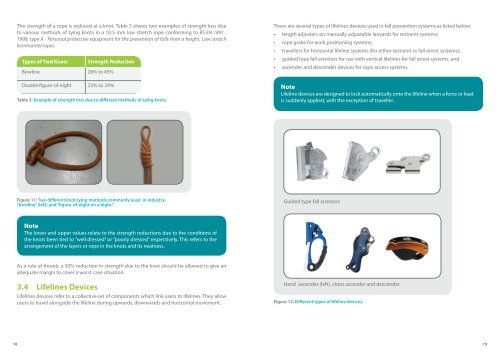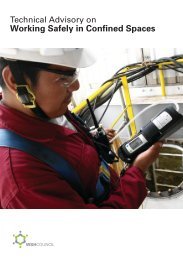HERE - Workplace Safety and Health Council
HERE - Workplace Safety and Health Council
HERE - Workplace Safety and Health Council
You also want an ePaper? Increase the reach of your titles
YUMPU automatically turns print PDFs into web optimized ePapers that Google loves.
The strength of a rope is reduced at a knot. Table 3 shows two examples of strength loss dueto various methods of tying knots in a 10.5 mm low stretch rope conforming to BS EN 1891 :1998, type A - Personal protective equipment for the prevention of falls from a height. Low stretchkernmantel ropes.Types of Tied KnotsStrength ReductionBowline 26% to 45%Double figure-of-eight 23% to 34%Table 3: Example of strength loss due to different methods of tying knots.There are several types of lifelines devices used in fall prevention systems as listed below:• length adjusters on manually adjustable lanyards for restraint systems;• rope grabs for work positioning systems;• travellers for horizontal lifeline systems (for either restraint or fall arrest systems);• guided type fall arrestors for use with vertical lifelines for fall arrest systems; <strong>and</strong>• ascender <strong>and</strong> descender devices for rope access systems.NoteLifeline devices are designed to lock automatically onto the lifeline when a force or loadis suddenly applied, with the exception of traveller.Figure 11: Two different knot tying methods commonly used in industry,“bowline” (left) <strong>and</strong> “figure-of-eight on a bight”.Guided type fall arrestorsNoteThe lower <strong>and</strong> upper values relate to the strength reductions due to the conditions ofthe knots been tied to “well dressed” or “poorly dressed” respectively. This refers to thearrangement of the layers or rope in the knots <strong>and</strong> its neatness.As a rule of thumb, a 50% reduction in strength due to the knot should be allowed to give anadequate margin to cover a worst case situation.3.4 Lifelines DevicesLifelines devices refer to a collective set of components which link users to lifelines. They allowusers to travel alongside the lifeline during upwards, downwards <strong>and</strong> horizontal movement.H<strong>and</strong> ascender (left), chest ascender <strong>and</strong> descenderFigure 12: Different types of lifeline devices.18 19
















